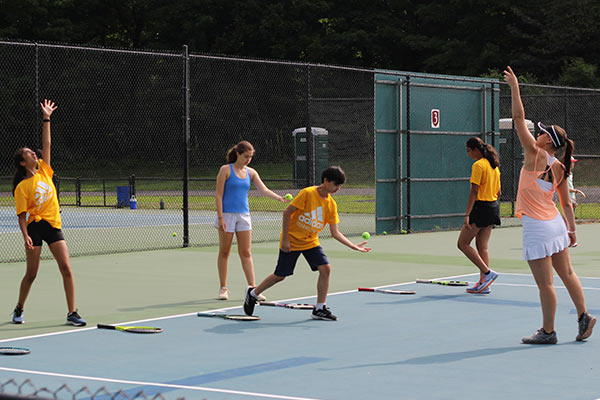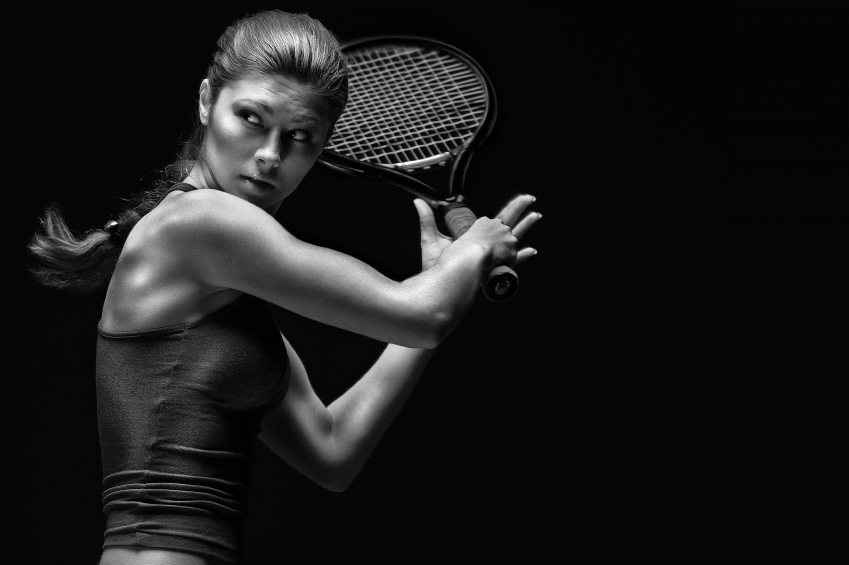What Are the 5 Basic Tennis Strokes?

For anyone who wants to start playing tennis, it’s important to know all the different ways you can hit the ball over the net! And for any who have played – whether you’re still a beginner or a competitive player – there are always ways to improve your technique.
It’s important to know the basic tennis strokes because this is the foundation of your on-court game. How you’re able to generate power and hone in your accuracy is going to play a huge role in how practice or a match will go.
So, what are the five basic tennis strokes, and what should you know about them? Before we get into that, let’s start with the basic mechanics of tennis.
Basic Mechanics of Tennis
Tennis is a captivating sport to watch: It’s like a dance, where every move counts, and it all starts with understanding the kinetic chain – a fancy term, but really, it’s all about how your body works together to make magic happen on the court. Think of it as a team, where every player has a crucial role in winning the point.
Lower Body: It all begins with your legs and feet. They’re the unsung heroes, setting the stage, getting you in the right spot. It’s like they’re saying, “Hey upper body, get ready, we’re about to send some power your way!”
Core: Next up, your core. This is where the real action starts. It’s like a powerhouse, churning and burning, turning that energy from your legs into a force to be reckoned with.
Upper Body: Now, let’s bring in the upper body. This is where things get flashy. Your torso and shoulders are like the conductors of an orchestra, directing all that energy through your arms, all the way to the racquet.
Arm and Racquet Execution: Speaking of racquets, your arm and that beloved racquet are where the magic culminates. This is the grand finale of the kinetic chain, where all that teamwork pays off, and bam! The tennis ball goes flying over the net (hopefully not into it!).
Smooth Follow-Through: And let’s not forget about the follow-through. It’s like the bow at the end of a performance, ensuring everything went smoothly and setting you up for the next big shot.
Understanding this whole kinetic chain thing isn’t just about hitting the tennis ball; it’s about making your whole body work together in a beautiful symphony. So next time you’re out on the court, remember, it’s not just about the swing; it’s about the dance of your body, from your toes to your fingertips!
5 Basic Tennis Strokes
Serve
Tennis simply wouldn’t be the same without the serve – it’s the fundamental stroke that initiates play in every match! A serve involves a unique blend of technique and personal style, where the general motion is consistent, but the nuances vary from player to player. It’s about blending understanding your body’s mechanics with adapting the serve to suit your strengths and limitations.
In essence, a serve begins with:
- Adopting a Good Stance: Position yourself comfortably with your feet shoulder-width apart.
- Ball Toss: Practice tossing the ball into the air with consistent height and placement.
- Striking Overhead: Strike the ball overhead aiming for the diagonally opposite service box.
The grip most commonly used during a serve is a continental grip.
A common challenge for novices is avoiding the dreaded net serve. This video will help in mastering this essential skill, especially for beginners. To help you overcome this, here are some beginner’s tips as well:
- Increasing Consistency: Learn to serve with regularity and control.
- Improving Accuracy: Techniques to ensure your serve lands in the correct box.
Remember, the key to a successful serve lies in practice, understanding the basics, and then adding your own personal flair to it.
Forehand
The forehand stroke in tennis is often a player’s powerhouse, a go-to shot that harnesses the strength of their dominant hand. Why is this shot so pivotal? It’s because the forehand is not just about power; it’s a blend of technique, timing, and body coordination. The success of a forehand depends on sound footwork, a well-prepared racket position, and maintaining balance throughout the shot.
A good forehand groundstroke is important for baseline rallies, and in tennis, there’s hardly a player who doesn’t strive for a forehand that is both effortless and powerful. So, let’s break down how to make that a reality:
- Proper Grip and Stance: Start by holding the racket with a comfortable grip, usually a semi-western grip (the base knuckle of your index finger is placed on the third bevel) or eastern forehand grip (the base knuckle of your index finger is placed on the first bevel of the racket handle). Stand with your feet shoulder-width apart, knees slightly bent, and body side-on to the net.
- Racket Preparation and Backswing: As the ball approaches, turn your shoulders and hips, bringing the racket back. This backswing is crucial for generating power.
- Contact and Follow-Through: Swing forward to meet the ball in front of your body, transferring your weight from the back foot to the front foot. Follow through with your swing, finishing over your opposite shoulder.
The grips most commonly used during a forehand stroke are the eastern forehand grip and semi-western grip, as mentioned above, but a western grip is also used as well.
For beginners, mastering the forehand involves focusing on:
- Consistent Footwork: Practice moving your feet to position yourself optimally for each shot.
- Controlled Swing: Work on controlling your racket speed and swing path for better shot placement.
This video guides you through the essentials of crafting a formidable forehand. By understanding these basics and incorporating them into your practice, you can add both power and finesse to your forehand stroke. Remember, a great forehand is about more than just raw power; it’s about the harmony of movement, grip, and timing.
Backhand
The backhand stroke, also another ground stroke, stands as a crucial counterpart to the forehand, offering players a versatile response to tennis balls on their non-dominant side. There are two main variations of the backhand: the one-handed and the two-handed backhand.
- One-Handed Backhand: This style is known for its extended reach and effectiveness in managing balls that come close to the body. To execute it, position your body sideways to the net, transfer your weight from the back foot to the front foot as you swing, and hit the ball with a single arm extension.
- Two-Handed Backhand: Offering more control and stability, the two-handed backhand is particularly useful for handling high balls. To perform this, grip the racket with both hands, stand with your feet shoulder-width apart, and use both arms to swing through the ball, keeping your head steady and eyes on the point of contact.
The most common grip types for a backhand stroke depend on whether it is a one-handed or two-handed backhand. For one-handed, the eastern backhand grip and continental grip are common, while a two-handed backhand grip is commonly used for a two-handed backhand.
Choosing between the one-handed and two-handed backhand comes down to personal preference and playing style. If you’re uncertain about which suits you best, here are some tips:
- Experiment with Both: Spend time practicing each style to see which feels more natural and effective for you.
- Focus on Form: Once you’ve chosen your preferred style, concentrate on perfecting your form, stance, and swing.
- Add Advanced Techniques: As you become more comfortable, start incorporating advanced elements like topspin to enhance your backhand.
Once you get the form down of the one you like the most, you’re able to add things, like some topspin.
Volley
Mastering the volley is key to a well-rounded game. A volley is a shot made before the tennis ball bounces, typically performed near the net. It’s a blend of agility, precision, and quick reflexes, where the motion is less about power and more about placement and timing. Most of the work comes before the actual shot, so it’s imperative that you put yourself in the proper positioning.
To execute a successful volley, follow these steps:
- Compact Backswing: Keep your backswing short and controlled. A big swing is unnecessary for volleys and can throw off your timing.
- Contact Point: Make sure to contact the ball in front of your body, and slightly to the side. This positioning allows for better control and direction of the shot.
- Solid Footwork: Good footwork is essential. Stay on the balls of your feet, ready to move quickly and adjust your position as needed.
The grip most commonly used during a volley is a continental grip.
For beginners, volleying can seem challenging, but with these tips, you can start to build confidence:
- Practice the Ready Position: Stay alert and prepared with your racket in front, knees slightly bent, and weight forward.
- Work on Hand-Eye Coordination: Drills that improve your reaction time and hand-eye coordination will greatly enhance your volleying skills.
- Focus on the Follow-Through: Ensure a controlled follow-through with your racket moving towards your target. This helps with accuracy.
This video will guide you through the basics of volleying, offering visual demonstrations and tips to help you master this essential skill. Remember, a great volley comes from practice, understanding the fundamentals, and adapting the stroke to your style. Embrace the challenge, and soon volleying will become a seamless part of your game.
Overhead
The overhead stroke in tennis is a thrilling and powerful shot, often resembling a serve in its execution. It’s a stroke that exudes dominance on the court, allowing players to assertively finish off points. Unlike the serve, the overhead doesn’t begin with a ball toss; instead, it’s about capitalizing on a high ball, usually near the net.
Here’s how to perform an overhead stroke:
- Anticipate and Position: The key to a successful overhead is anticipating where the ball will land. Move quickly to position yourself under the ball, with your body side-on to the net.
- Ideal Strike Zone: Just like in your serve, aim to make contact with the ball in your ideal strike zone – usually above and slightly in front of your head. This allows for maximum power and control.
- Active Footwork: Footwork is more dynamic in an overhead stroke. Adjust your feet continuously to align your body correctly under the ball.
The grip most commonly used during an overhead stroke is a continental grip.
For beginners, mastering the overhead stroke can be a game-changer. Here are some tips to get started:
- Practice Your Footwork: Work on moving quickly and efficiently to get under the ball. Good footwork is essential for a well-positioned overhead.
- Work on Timing: The timing of your swing is crucial. Practice hitting the ball at the top of your reach to maximize power.
- Controlled Swing: Focus on a controlled, fluid swing. Over-swinging can lead to loss of control and accuracy.
How to Improve Your Tennis Stroke
Enhancing your tennis strokes encompasses more than just practice on the court; it’s about embracing a holistic approach to improvement. Attending a tennis camp offers an immersive experience, allowing you to learn from seasoned coaches and play alongside peers who share your passion. Tennis lessons are invaluable for receiving tailored guidance and feedback, helping you refine your technique and strategy and can help you build off of what you learned at camp. Incorporating tennis drills into your routine is essential for building muscle memory and honing specific aspects of your game. Furthermore, watching instructional videos can be a convenient and insightful way to learn new tips and observe the nuances of professional play.
Remember, improvement in tennis is a journey, combining dedicated practice, learning from experts, and continually challenging yourself. By integrating these methods, you’ll be on your way to elevating your tennis strokes and overall game.
Interested in signing up for an adidas Tennis Camp this summer? Click here to find a camp near you and receive more information.



